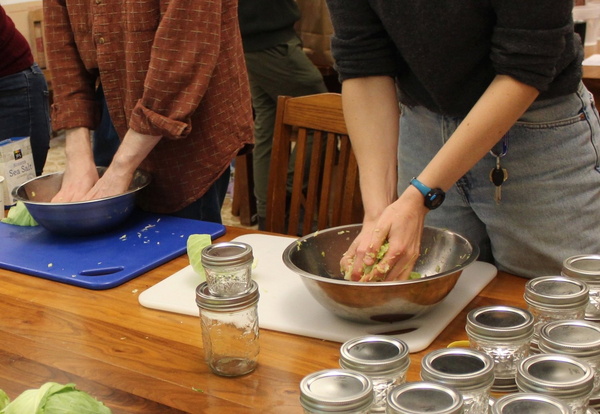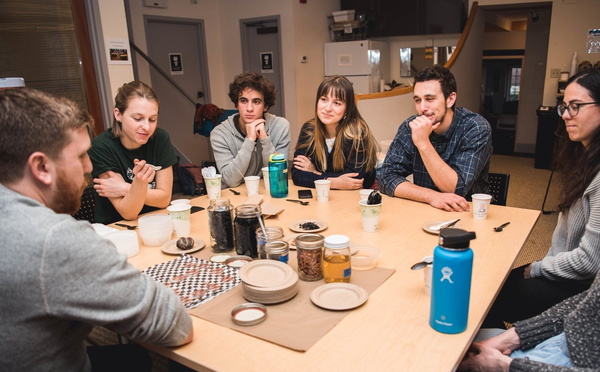From Sourdough to Kimchi Students Explore the World of Fermentation
“Your mother is in the fridge, and you must feed her.” This instruction may have startled anyone passing through the Marsh Hall classroom on a Friday afternoon this October, but to those gathered around the table with Charlie Negaro Jr. of New Haven’s Atticus Bookstore Café, it was a mandate to begin their journey with sourdough bread making.


The “mother” Negaro referred to was the culture of bacteria and yeast, known as “starter,” that all sourdough loaves are born from.
Negaro’s hands-on walkthrough of starter creation — complete with taste testing —was part of the first day of a Fermentation Intensive put on by Tsai CITY and the Yale Landscape Lab. Intensives, a popular program format at CITY, are cohort-based, extracurricular learning opportunities that offer a chance to delve into a specific topic. Over four three-hour sessions this fall, the Fermentation Intensive gave students a hands-on introduction to the process that’s behind sourdough, kimchi, beer, and much more. Dozens of people applied to join the Intensive, which was open to students from across Yale’s campus.
This diversity was clear on the first day of the program, as the Intensive’s organizers, Justin Freiberg, a mentor-in-residence at Tsai CITY and director of the Landscape Lab, and Haley Leslie-Bole, a first year Master of Environmental Management student at the School of Forestry & Environmental Studies, kicked things off with introductions. No two participants, it seemed, were taking the same approach to their studies at Yale. With a group that included undergraduates (including first-years), a third-year Ph.D. candidate in history, microbiologists, and master’s students from the Schools of Management and Forestry, the only common denominator was a curiosity about the history, science, and practice of fermentation.
In addition to creating sourdough starters, students rotated through two other stations on that first day: Bentley Lim of Yale’s Goodman Lab led the students through sauerkraut making, and Loick Fenaux (EMBA ’19) of Naturex talked to students about the raw materials and industry of fermented foods. Fenaux, Lim, and Negaro were the first of an impressive lineup of experts who taught in the Intensive, which during the Intensive’s second session included Peter Kaiyan and Audrey Baeza of Momofuku Culinary Lab, Jori Jayne Emde of the Hudson restaurant Fish & Game and Lady Jayne’s Alchemy, and Lucy Kahn of Real Pickles. These practitioners helped students see how one could move from the basic practices they’d explored the previous week — each student had left the first session with their own ferments to cultivate — to a business, with discussions of scaling up culinary processes and current industry trends.
Though humans have been fermenting food since the latter part of the Stone Age, live, fermented foods have only recently shot back into widespread popularity, igniting a growing food movement in the process. Considering this spike in status, Leslie-Bole speculates, “I think research about the microbiome and the immense health benefits of probiotic foods are becoming increasingly well-known. This coincides with a growing market for health foods and, accordingly, people are turning to products like kombucha and sauerkraut for both the flavor and the reported health benefits.” The research into these health benefits is growing alongside the industry of the foods themselves. The Intensive’s third session brought these elements together, turning the cohort’s attention to fermentation’s relationship to the human body.

As a microbiology graduate student and Lim’s colleague at Yale’s Goodman Lab, Emily Putnam contributes to the growing body of research on the microbiome, the collection of microbes on and in us. Speaking to Intensive participants, Putnam explained that there is a lot more to be learned about probiotics than is currently known. Probiotics — essentially just bacteria used for presumed health benefits— may even pass right through the gut without making any real difference, she noted. Though probiotic science is a relatively young field, early research has suggested positive effects that range from fighting oral cavities to regulating digestion. The new field of psychobiotics, meanwhile, studies the effect of microbiotic health in the digestive tract in relation to mental health and brain function, the so-called “gut-brain connection.” While researchers like Putnam study probiotics’ potential benefits, the probiotic industry to continues to expand.
Amid this buzz, the toast of the culinary town this fall is the new book from internationally acclaimed restaurant Noma, The Noma Guide to Fermentation. The new book was adapted from the self-published handbook A Field Guide to Fermentation by Lars Williams and Arielle Johnson, the architect of Noma’s fermentation lab, who also joined the Intensive’s third session. Johnson, who has a Ph.D. in environmental and agricultural chemistry (with a focus on flavor), began her session with a demo. She distributed a jelly bean to the students and asked them to eat the jelly beans with their noses plugged at first, then to release their noses after a few seconds of chewing. The beans at first tasted sweet and grainy in the way of crystalized sugar, but upon nasal release, the individual flavors of the jelly beans revealed themselves; it was only through their sophisticated olfactory sense that the students could distinguish green apple and buttered popcorn. Johnson was demonstrating our sensitivity to smells, an essential component of our appreciation for fermented food.
The influence of the new, official version of her book has wafted throughout the culinary community, and, fittingly, cuisine and community were the focus of the final session of the Intensive. Matt Wick of Osa Restaurant reported that the book had supercharged him. He said, “The information in there is just so clear and concise and makes so much sense. It’s weird that no one has written about it in that way yet.” Wick — along with James Wayman of Oyster Club, Grass & Bone, and Engine Room, and Rick Shih, who runs OurCookQuest— had been recruited to participate in the final session by Negaro. The four of them — Negaro, Shih, Wayman, and Wick — got to know each other because of their passion for inventive, local food and fermentation. After the group shared stories of their food-driven adventures, the focus turned to eating: the chefs had brought in a sampling of their most delicious fermented dishes. To begin his breakout session, Shih asked the participants to break bread — literally. One brave group member confronted a large loaf of Negaro’s golden sourdough and tore into it. Shih also provided an umami bomb of compound butter with ricotta and a fermented cherry blossom salt that Wick had made, the ultimate community recipe. The only rule for consuming the bread? The participants couldn’t rip their own hunks. In order to enjoy the community snack, another member of the community had to be the one to provide it.
As students at one table sampled foods and talked, Negaro took stock: of the people at the table, only two still had living sourdough “mothers.” In the weeks following the first Intensive session, some students hadn’t been able to feed their starters when they had left for the Thanksgiving break, while others had struggled with the unpredictable temperature fluctuations of student housing. Negaro seemed disappointed, but not because his students had failed at the difficult task — he had a bet with Freiberg. Negaro had taken the under and Freiberg the over on two of the group’s starters surviving, and, at exactly two, the bet was now moot. But complete success was never the point. Freiberg had assured the group on the very first day that the Intensive was a space in which they could “let go of perfection and learn from the process.” Negaro echoed that he was almost more frustrated when things went perfectly, because there was less to be learned.
Though not all of the bacterial communities of the Intensive survived the five-week course, the human fermentation community had grown. As the students sampled another treat — an inventive ice cream cone made with corn grown by the same Connecticut family since 1643 — the experts seemed to agree: that newfound community was as good (or almost as good) as the cocoa-masa koji ice cream cone with fermented crème fraiche cow’s milk caramel corn-based ice cream, anyway.